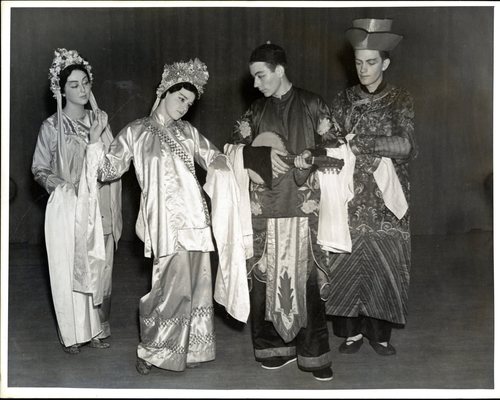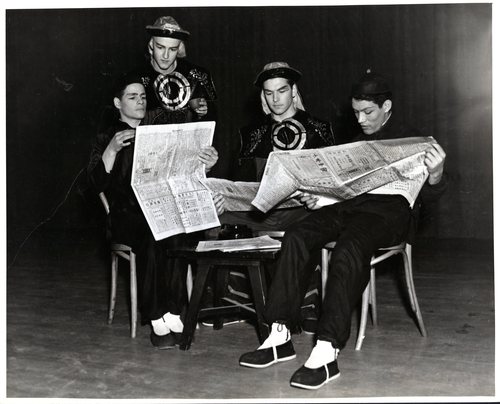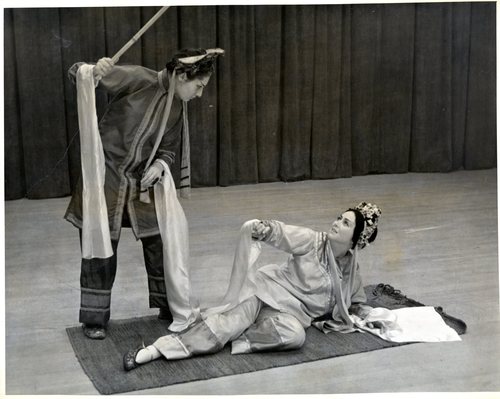Funny thing happened this week. While entering the Seymour Papers’ finding aid into the library’s records system. I had to double checked the written directions given to me because I could not remember how to do something. While reading the directions, it stated that the selection I clicked should have auto-populated the information I needed. I had a moment of panic because nothing auto-populated!!! Surely I must be doing something wrong! I moved onto task 2 and the same thing happened! As someone who HATES doing something incorrectly I quickly shot off an email asking for help. Turns out the part of the directions that stated information would be auto-populated was outdated. When changing the directions from how to use the old system to how to use the new system, this one sentence accidentally got left behind. Luckily the instructions can now be updated so that way future fellows won’t suffer momentary heart failure.
Back from Vacation for the Presentation
After spending 2 weeks abroad, I quickly got thrown back into work when I found out my final CCEPS presentation had been scheduled for my second day back to work. So
Off to London
Tomorrow evening this archivist takes off to explore Europe for the next 2 weeks. A few of my days will be spent in London. I thought this made an excellent opportunity to share one of the postcards John Laurence Seymour brought back from his European trip in 1922/1923.
Seymour would purchase post cards as souvenirs to keep for himself, and frequently made notations on the back of them with personal descriptions and anecdotes. Below is a postcard of the Tower of London with Seymour’s notations on the back included.
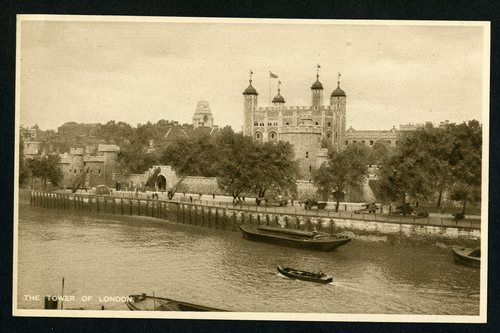
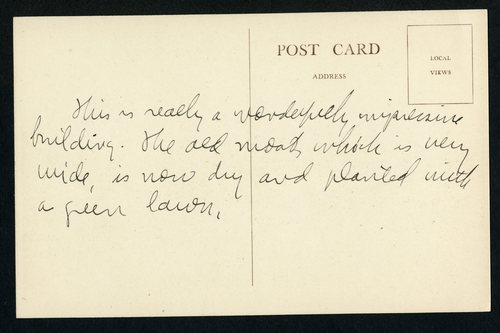
Secondary Sources
When processing an archival collection, generally, you are dealing strictly with primary sources. While that is a fantastic experience, sometimes some secondary sources can be incredibly helpful to help one synthesize and put into context the files upon files of documents.
One of, if not the, best secondary source about John Laurence Seymour is a chapter from a book about Mormons at the Metropolitan Opera, written by Glen Nelson. The chapter “Digging Up the Pasha’s Garden” looks at both Seymour and his experiences related to his opera, In the Pasha’s Garden, performed at the Met in 1934/1935. I have found the chapter particularly helpful in writing the finding aid for the John Laurence Seymour Papers, and I would highly encourage others to read this chapter as well.
Opera Advertisements- Part 2
Last week I promised for a solution for the over-sized posters, and luckily we worked something out. The large posters that are too big for even the map drawers will be folded either in half (or in quarters based on how giant the poster is). The goal is basically to have as few folds as possible. Then, we will make custom sleeves for each folded poster out of Mylar, in order to help prevent any further damage and to keep pieces which have ripped off together.
Those sleeved posters will then go into a giant file with all of the other over–sized posters from this collection, and placed safely in the map drawers. Sadly, because these posters are so large and fragile, there is really no way to safely scan them with the resources we have here at the library…. However I was able to take a photo of one of the larger and more delicate posters with my phone, which is the photo below. The poster is from around the turn of the century and advertises an opera titled, “Adriana Lecouvreur”.

Opera Advertisements- Part 1
Hidden away in the last few unprocessed folders of the Seymour Collection hid some of the most beautiful opera advertisements this archivist has ever seen first-hand. The full-color advertisements range in size from a small 4×12 inch flyer to an enormous 77×40 inch poster. Archiving the flyers typically follows the same process as any other paper item, so long as there is no damage to the flyer.
However, the large posters prove more difficult. Paper items should always be stored as flat as possible, but an item over 6 feet in length proves trickier. Archival drawers are often the solution for large items, however even those are only so big. Honestly, I am not totally sure what we are going to do with this giant poster yet. It is seriously massive, and to complicate matters further, it is also pretty fragile. Even an archival drawer would not provide enough space to lay the poster flat. Stay tuned next week….. hopefully we will have a solution then!
Until then though, enjoy these significantly more manageably-sized flyers for the operas: Iris, Madam Butterfly, Giovanni Gallvrese, and La Figlia Di Iorio.
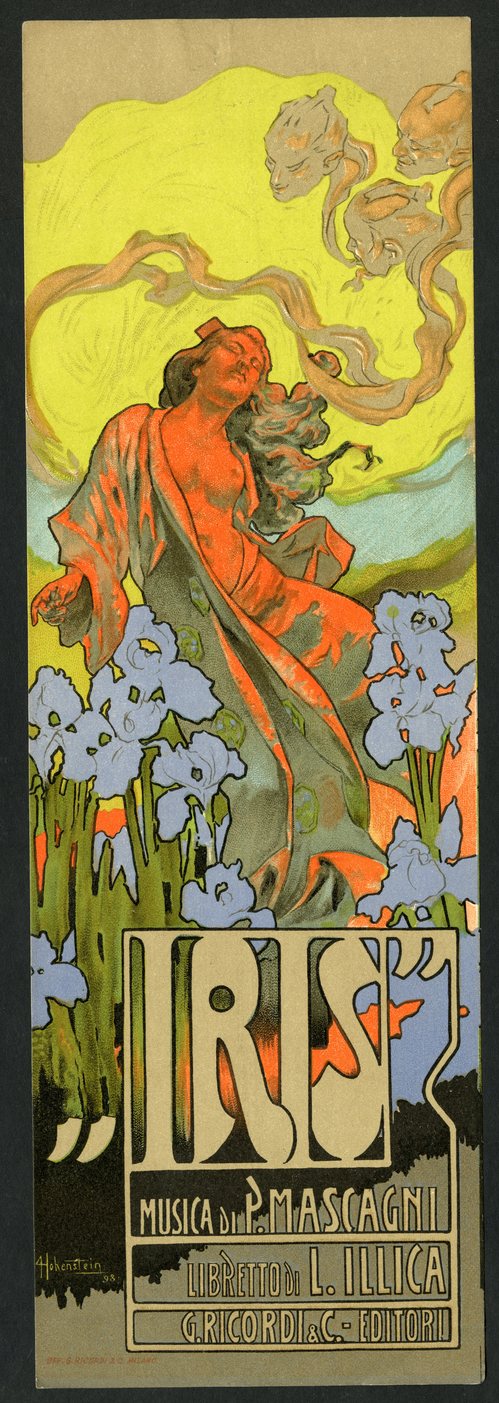
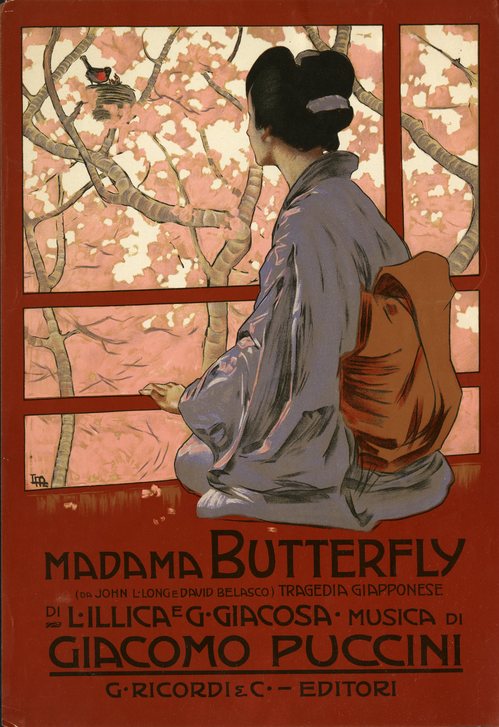
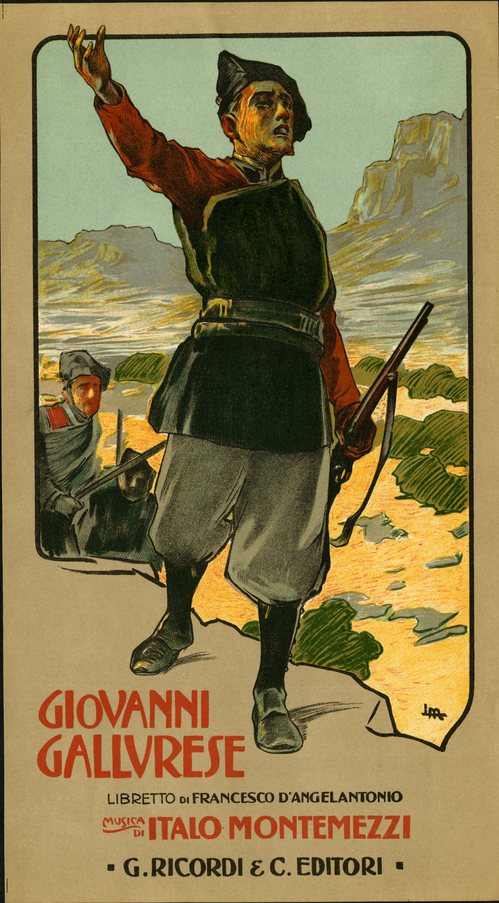
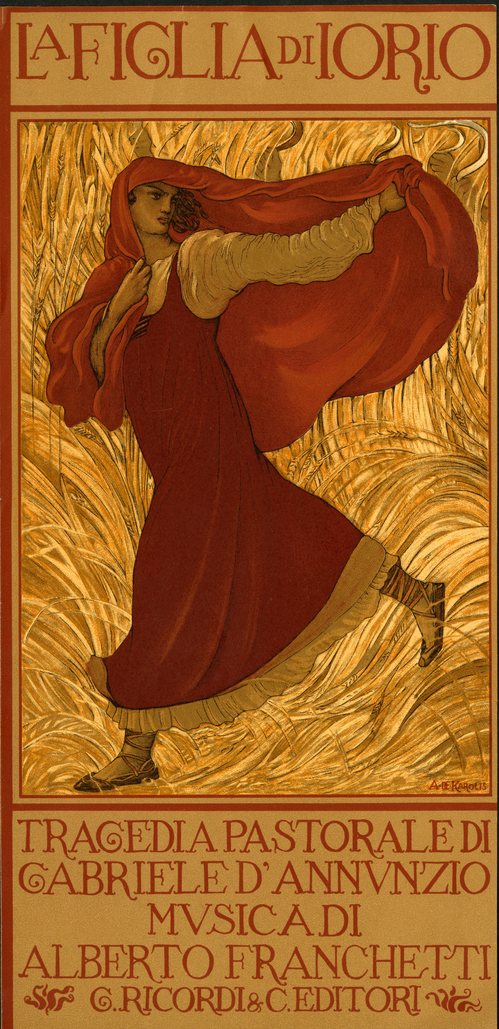
Archiving Pro Tip: Erasing
Hopefully it should be no surprise that paper is made up of pulp derived from fibers of wood (or sometimes other fibrous materials such as grasses or cotton). These fibers are layered and pressed in a way that means each fiber is positioned in its own unique direction. Keeping this in mind, there is actually a trick when erasing a mistake made with pencil. While a lot of people may move their eraser quickly side to side, or up and down, this is not the most efficient way to erase. The best way is to move your eraser in a circular motion, both clockwise and counter-clockwise. By moving the eraser around in this manner it shifts the fibers of the paper in all directions, which means all of the tiny little fibers can be fully massaged by eraser! Be sure to try this trick next time you need to make a quick correction!
Brother of the Alpha Kappa Lambda
On September 7th, 1914, John Laurence Seymour became an initiated member of the Alpha Kappa Lambda Fraternity. Founded as a national fraternity on April 22, 1914, Seymour became an early inductee of the organization. UC Berkley would be the Fraternity’s only chapter until 1921 when their Gamma chapter was founded at the University of Illinois Champaign-Urbana. Today AKL boasts 39 chapters and colonies, 1,064 active members, and 26,187 alumni members.
Seymour frequently made contributions to the Fraternity’s publication The Logos. He wrote a poem for the first issue of the The Logos, originally called the Diamond, in January of 1915. In the November 1926 edition, Seymour provided the opening article, “Opera and Life”, followed by a second part titled “Opera in the United States” in the June 1927 edition. Seymour contributed again in May of 1929 with a piece titled, “Some Interesting Spots in France.” Finally, Seymour’s accomplishments were highlighted and applauded in the February 1926 edition by a former Senior Grand President of the Fraternity.
Below is a copy of Seymour’s original initiation certificate.
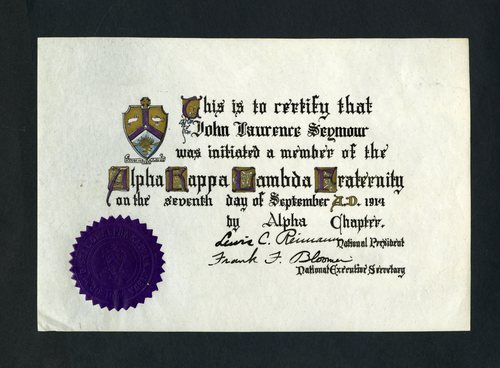
Learn more about the Alpha Kappa Lambda Fraternity.
Archiving Pro-Tip: Folder Numbering
An important part of archiving is folder numbering. Each folder is given a number based on its position within a box. So for example, the 5th folder in box 2 would be labeled, “folder 5, box 2.” During the early phases of processing a collection, it can be tempting to label a folder as soon as it is full and placed in a box. However, the best time to number folders is toward the end during the process of creating a folder list.
Frequently, when archival collections are taken in by an institution, items within that collection are not organized in any particular order. In order to make the collection as accessible as possible to researchers, some kind of order needs to be made of the collection. This means dividing the collection into a few different series that intellectually make sense. Common series groupings include biographical information, correspondence, and photographs. Each collection is unique, as is each archivist, so series titles and groupings vary from collection to collection. Series can change throughout the processing stage depending on what items the archivist discovers.
Oversized or oddly shaped items are another factor to take into consideration while folder numbering. Even though intellectually the oversized items may belong to the correspondence series, they will not fit into the same size box as the other items. These items will be pulled and placed in a separate oversize box. However they will remain in order with the rest of the series item on the actual folder list. The folder list will notate
the separated location.
All of these factors affect what a folder is numbered, and that is why the numbering process should not begin until the creation of the folder list. Otherwise, you may have to renumber your folders multiple times, taking up precious archival time.
“The West Chamber”
As highlighted in a previous blog post, John Laurence Seymour’s production of A Protegee of the Mistress constituted the first production of that particular play in the United States.
Nine years after that performance Seymour picked another play to perform for the first time in the United States. For the first time ever, the English-language production of The West Chamber took stage in 1938. Touted as a “Chinese Classic” in local newspapers the show included meticulous research on traditional Chinese stage-makeup, props, and staging in order to faithfully re-stage the production in the United States. However, one glaring issue with the production is that the entire cast was white.
Actors donned makeup which relied on thick black eyeliner to create sharp, angled eyebrows and also to create the illusion of almond-shaped eyes. This heartily begs the question, is this considered an example of, “yellow face”? A significant effort was made by Seymour to share his appreciation of Chinese culture and to teach both actors and the audience about traditional Chinese Theater (see program notes included below). Far from creating a caricature of Chinese peoples and cultures, the production seemingly constituted a faithful recreation of the play originally written in 1250AD by the Chinese playwright, Wang Shih Fu.
Regardless of good intention though, it is hard to forget the fact that the Chinese Exclusion Act would not be repealed until 5 years after this production. One year prior to this production, the Hollywood movie version of The Good Earth was released. Set in Northern China during the years leading up to WW1, the film follows a Chinese farming family and their numerous struggles.
Even though Asian-American movie star, Anna May Wong had been considered for the main role, she never received an offer for the part because of the white, male lead, Paul Muni. Due to anti-miscegenation rules in Hollywood during that time, any actress playing Muni’s wife also had to be white. Due to these kinds of laws and ever-present racism, it became basically impossible for Asian’s and Asian-Americans living in the United States to tell their own stories in any kind of theater.

